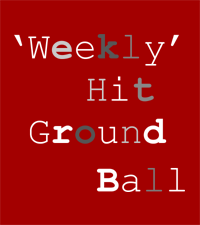 I looked at the MLB standings for the first time this season on Saturday morning. I deliberately avoid them completely during the early stages of the campaign, at least until curiosity gets the better of me, and it isn’t until halfway through May that I check them on a regular basis.
I looked at the MLB standings for the first time this season on Saturday morning. I deliberately avoid them completely during the early stages of the campaign, at least until curiosity gets the better of me, and it isn’t until halfway through May that I check them on a regular basis.
The standings don’t mean all that much until teams have played a decent number of games. Teams are just getting out of the gate, sometimes without their full complement of first-choice players. A few games will be postponed here and there due to bad weather and win-loss records can be inflated or deflated due to the quality of opponent that each team has faced up to that point.
In short, you simply don’t get a sense of how good a team is, just how well they have performed over a relatively small number of games.Â
However, that doesn’t mean the standings are devoid of any interest. In fact, the occasional glimpses early on can be a source of great pleasure and intrigue. You get a sense of how teams are doing by following individual results and winning or losing streaks every day, but checking how the teams stack up can still create a shock or two.
That was the case on Saturday.Â
Firstly, the American League Central division was seemingly displayed upside down. The defending champion Minnesota Twins, my pick for the 2011 division, were rock bottom with a 4-9 record. The Detroit Tigers and Chicago White Sox were fourth and third, while the Kansas City Royals and Cleveland Indians were joint-leaders on 9-4. That couldn’t be right, surely?
Then I looked at the Major Leagues as a whole. The Boston Red Sox, widely tipped as being destined for the World Series, had the worst record in baseball. I knew they had struggled in the early going, but seeing them at the bottom of the pile still made for a shock.
Much as Yankee fans would love to see it happen, the Red Sox aren’t going to stay down there for long. They have too much talent, and too many resources as an organization, not to jump back up into contention. Even during a demoralizing start, Boston found a way to demonstrate that.
The Red Sox announced on Friday that, as expected, they had signed off-season recruit Adrian Gonzalez to a seven-year contract that will pay him $154m over the duration (£94.4m, or approximately £260k per week). Adding a premier player in this way is the sort of move that allows teams like Boston to stay ahead of the chasing pack.
The organization had the funds and staff that made the deal possible, allowing them to acquire the prospects that were traded away, being able to replace those prospects (in time), and factoring in the lucrative long-term deal to lock Gonzalez up before his scheduled free agency in the 2011/12 offseason.Â
By agreeing to the deal now, Gonzalez’s 2011 salary goes into the books as the original $6.2m he was due to be paid. That’s important because it’s the original roster cost that is used to calculate the team’s revenue-sharing contribution. Revenue sharing is designed to bring a bit more financial equality to MLB, which the big teams reluctantly agree to partly on the argument that spreading the wealth should create more competition and generate more interest in the sport. However, the rich don’t obtain that status by letting money go to waste and if there’s any way they can exploit a loophole, they will take it. That’s exactly what the Red Sox have done here (admittedly they were also waiting to see that Gonzalez was fully recovered from off-season shoulder surgery).
If the Red Sox’s spending makes it unlikely they will stay in the celler for long, the comparative lack of funds available to the Indians and Royals is a strong reason why their early season form is just as unlikely to last.
The Cleveland Indians are a prototypical ‘window’ team. Their resources do not allow them to compete every year, so they build themselves up to create a window of opportunity of a few years before their best players become unaffordable and are traded for prospects to start the process again. The Royals technically are in the same situation, although half-hearted attempts to compete have resulted in the windows remaining firmly shut in recent years, with a third-placed AL Central finish in 2003 being the best they have achieved in the new millennium.
That may soon change in Kansas City if they can successfully turn their prized group of prospects into top-level Major Leaguers. Many of those prospects have been acquired thanks to the prime draft picks that the worst-performing teams are given each year. Much like revenue-sharing, the process of drafting in reverse order to the previous year’s MLB record (the best team gets pick number 30 etc) is designed to allow the weaker teams to catch up; however, just as the Red Sox can exploit the revenue-sharing loophole, some teams seem to benefit unfairly by the draft order rule.
It was confirmed this week that the Pittsburgh Pirates will have the number one pick in the 2011 amateur player draft. The Pirates haven’t even pretended to compete for a playoff spot in over a decade. Rather than face the doom of relegation or some other sanction, Pittsburgh’s failure is effectively being rewarded by allowing them to pick first.Â
That doesn’t seem quite right, but the central idea of allowing the lesser teams to compete has to be a good thing for the sport. While the Royals and Indians aren’t likely to compete this year, and the Red Sox’s financial might should ensure they soon start to climb the standings, there is hope for the future.
And until that future comes, we can still enjoy the oddness of the early season standings.